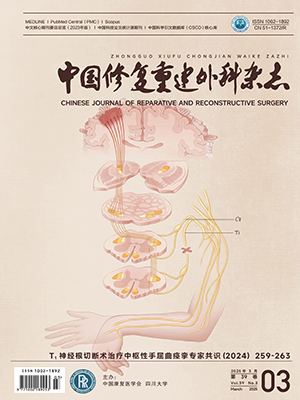ObjectiveTo study the effect and feasibility of poly-lactide-co-glycolide (PLGA) loaded with recombinant human bone morphogenetic protein 2 (rhBMP-2) on repairing articular cartilage defect in rabbits. Methods PLGA was made into cylinders which were 4 mm in diameter and 3 mm in thickness. rhBMP-2 was fully homogenated before used. PLGA combined with 0.5 mg rhBMP-2 under the condition of vacuum(700 mmHg),and then lyophilized, packed ,sterilized with ethylene oxide and reserved. Defects of 4 mm in diameter and reaching medullary cavity were made in femoral condyles of 72 two-month-old New Zealand white rabbits. The 36 right defects were repaired with PLGA-rhBMP-2 composites as the experimental group, the 36 left defects with PLGA only as PLGA group, the other 36 left defects were left untreated as control group, and the other 36 right defects with PLGA-MSCs composites as cell group. At 4, 8, 12, 24, 36 and 48 weeks after operation, macroscopical and microscopical observations were made, and the histological grade wasdone.Results After 4 weeks of operation: In the experimental group and cell group, defects were filled with white translucent tissue which appeared smooth and soft; the matrix around chondrocytes was weakly metachromatic, the newly formed cartilage tissue was thicker than normal cartilage tissue; there was no formed tissue in the PLGA group and the blank control group. After 8 weeks of operation: In the experimental group and cell group, the new tissue was white, translucent, tenacious and smooth. The boundary with normal cartilage became vague. New cartilage cells distributed evenly. The cells of the surface layerparalleled, but the deeper layer lost directivity. The matrix dyed weakly. The new cartilage gradually became thinner, but it still thicker than the normal cartilage ones. The PLGA degraded besides some drops.In the blank control group and PLGA group, a little white membrane formed at the bottom of the defect. After 1224 weeks of operation: In the experimental group and cell group, defects were filled with new tissues which were white, translucent, tenacious and smooth. The boundary disappeared.The thickness of the new cartilage was similar to that of the normal ones. The cells of the surface layer paralleled to each other,but the cells of the deeper layer tended to arrange vertically. The matrix around chondrocytes was metachromatic,but the color was lighter than that of the normal cartilage. Bone under the cartilage and the tide mark recovered. The new cartilage linked with nomal cartilage finely.In the blank control group and PLGA group, there was a little fibrous tissue at the bottom of the defect withe obvious boundary. After 36 weeks and 48 weeks of operation:in the experimental group and the cell group, the new cartilage was slightly white,continuous and less smooth. The boundary disappeared. There was no proliferated synovial membrane.The thickenss of the new cartilage was thinner than that of the normal ones. The matrix around chondrocytes was weakly metachromatic. In the blank control group and PLGA group, the defect still existed, but became smaller.At the bottom of the defect, fibrous tissues formed. Some cartilage denudated and became less smooth.Some bone under cartilage exposed,and the synovial membrane became thick. The histologic grade of the repair tissue at 12 weeks and 24 weeks of operation in experimental group and cell group was significantly different from that at 4, 8 and 48 weeks of operation(P lt;0.01). There was also significant difference in the experimental group and cell group compared with the blank control group and PLGA group at each time after operation(P lt;0.01). But there was no significant difference between the experimental group and the cell group. Conclusion In the course of degradation。。。。。。.
Citation: CUI Yuming,WU Ji,HU Yunyu.. REPAIR OF ARTICULAR CARTILAGE DEFECT WITH POLY-LACTIDE-CO-GLYCOLIDE LOADED WITH RECOMBINANT HUMAN BONE MORPHOGENETIC PROTEIN IN RABBITS. Chinese Journal of Reparative and Reconstructive Surgery, 2007, 21(11): 1233-1237. doi: Copy
Copyright © the editorial department of Chinese Journal of Reparative and Reconstructive Surgery of West China Medical Publisher. All rights reserved




